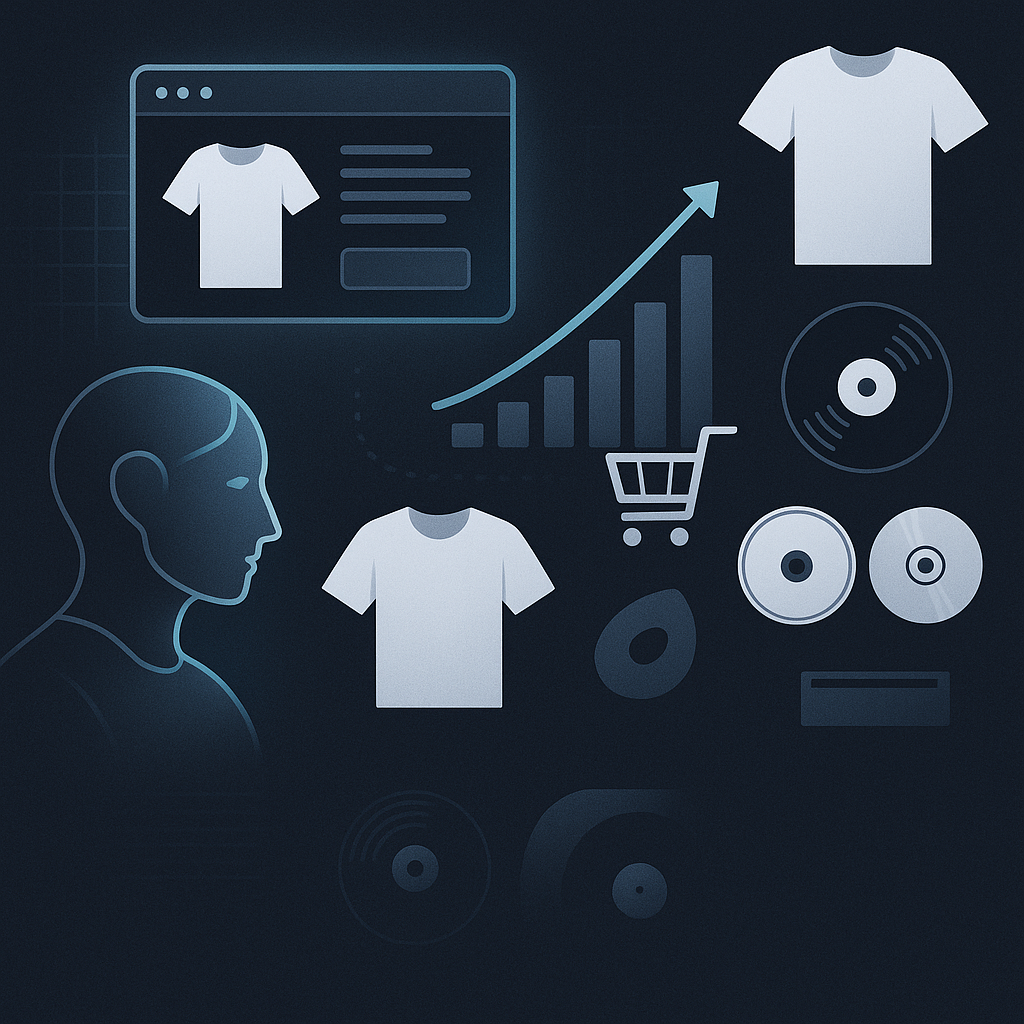Why Merch Matters
September 9, 2024

Introduction
In the ever-evolving music industry, artists have access to numerous channels for monetizing their work. It's crucial to recognize the financial differences between income from merchandise sales, streaming, live performances, publishing, synchronization, and other revenue sources. While streaming and live performances are integral to an artist's career, the financial potential of merchandise sales is evidently higher on a margin basis. For example, the current payout rate for a thousand streams from Spotify is about $2.83; in contrast, selling one t-shirt at $30 equals roughly 13,000 streams before costs. While focusing on streaming and live events is essential, artists simultaneously should build their merchandise business from an early stage. This is particularly crucial in an industry where artists must generate substantial income to support themselves and their art. Merchandise offers a lucrative avenue for artists to supplement their earnings, ensuring a more stable and diversified revenue stream in the highly competitive and rapidly changing music industry.
Merchandise & Fan Engagement
Fans are seeking ways to connect with their favorite artists, creators and celebrities; licensed merchandise offers a tangible way to do so. One key factor driving merchandise sales is the rise of social media and online communities. Fans interact with their favorite brands and celebrities more directly and personally than ever before. Fans constantly consume content across many platforms, causing fans to feel like they have a unique and personal relationship with their favorite creator. These interactions foster a deeper sense of loyalty and connection, motivating them to purchase merchandise to express their fandom. Merchandise is a conduit for fans to express their beliefs and emotions through fashion.
Furthermore, social media platforms allow fans to showcase their merchandise collections and share their experiences. Fan-sharing creates a ripple effect, normalizing the purchase of branded merchandise and encouraging others to follow suit. As fans see their peers flaunting their collections, it fuels a desire to participate in this culture, further boosting sales. This growth clearly indicates the changing landscape of fashion and consumerism, where personal identity, fan culture, and social media interplay to drive market trends.

Streaming
Technology has played a major role in the democratization of music both in creation and consumption. Many artists can make hit records using a simple computer and Digital Audio Workstation (DAW) compared to the past when artists needed to purchase studio time, engineering services, equipment, and usually the financial backing of a record label. The barrier to entering music was much higher before the availability of DAWs and the computational power of modern computers. Once a song is written, produced, mixed, and mastered, artists can easily upload their music. Using a distributor like Tunecore, CD Baby, or Distro Kid, music is easily distributed to all DSPs, passively collecting royalty payments across all platforms.
Fan’s Dictate Marketplace Action
In the past few years, social media, streaming, and the “do it yourself” (DIY) culture has evolved Record Labels’ influence over the music market. Historically, most artists became popular because of large investments by the record label into: marketing, promotion, media, and using their power and influence to push records to the top of the charts on radio, magazines, record stores, and popular culture. However, a creator can now quickly produce a song on a laptop, distribute the song to DSPs in 24 hrs, create a series of social media posts on TikTok, Instagram, and YouTube, and become an overnight sensation. There are many artists who have taken the DIY approach and have widespread media presences with strong streams and shows booked. JVKE, Lauv, and Fly By Midnight are examples of artists taking the DIY route and becoming extremely successful. The total democratization of all facets of music production, distribution, and promotion, means artists no longer need contracts from record labels to become popular and gain an audience. That said, record labels continue to play an important role for many artists, providing finances and a team to help catapult trending artists into the next levels of fame and earning power.
On the demand side of music consumption, fans are bombarded with content, music, and media. Thus, fans decide which content wins and beats out other content, the market decides what is popular. The landscape has changed, whereby the supply is much greater, lowering the bar for both distribution and consumption. Given the increased competitions, midsize artists need to look for new and innovative ways to standout and generate revenue. The industry has traditionally focused on maximizing revenue in the touring, publishing, streaming/royalties subsets however there is a shift to new innovative solutions.
Traditional Industry Conduct
Merchandise has historically been treated as an afterthought by many artists and managers. However, the industry is shifting. In an article published on Music Business Worldwide, a leader in Music Industry news, Mark Meharry CEO of Music Glue explains how “‘The Music Industry is Leaving Billions on the Table Because We Frustrate Fans'’” (Music Business Worldwide, 2016). He explains that to purchase a t-shirt, vinyl, or CD fans are redirected to multiple different websites forced to enter their information multiple times, interact with a few different customer service centers just to wait weeks for the product to arrive (Music Business Worldwide, 2016). Even in 2024, years after those comments, many artists still either do not have a merch store, or an outdated one. The industry is gradually changing to adopt the current e-commerce industry standards such as modern website design, customer service, fast shipping times, and technology integration. Mainfactor is one such example, as an e-commerce-as-a-service company that supports artists and their teams to manage direct-to-consumer and merchandising operations end-to-end for clients. Mainfactor is leading the way in modern store design and optimization and commerce operations, all while maintaining high quality products that truly excite fans.
Artist Merchandise on Artists’ Revenue Stream
Merchandise is growing in importance in the modern music industry and serves as a vital revenue stream for artists. Streaming platforms offer immense exposure and accessibility, but often provide artists with a fraction of the revenue compared to traditional album sales. Examining the financial statements of Universal Music Group (whose e-commerce division, Fame House, was founded by Mike Fiebach- also the founder of Mainfactor, Fiebach served as Fame House’s CEO from inception in late 2010 through February of 2020 and integrated the business into UMG in 2016, eventually taking over all of UMG’s e-commerce operations) in 2020 merchandise generated 292 million euros, in 2021 363 million, and 2022 generated a 54.1% increase to 618 million (Deloitte & Associes & Ernst & Young et Autres, 2022). In contrast, streaming revenue only grew by 9.8% year over year from 2021 to 2022 (Deloitte & Associes & Ernst & Young et Autres, 2022). Merchandise is a significantly faster growing stream of revenue for the music industry when compared to streaming. Costs associated to produce merchandise compared to the revenue generated provides a lucrative business opportunity for artists and rights holders.

Super Fan Monetization
The music industry in recent years is emphasizing super fans as a crucial component of an artist’s business. Super fans are defined by their overzealous nature in purchasing and consuming content and products from artists. Artists can easily promote and market to their highly engaged fan base increasing the likelihood of overall sales. There is a common concept in the Music Industry that states if 1,000 fans spend $100 it equates to $100,000 a year straight to the pocket of the artist after costs. Creating a fan base that is engaged is a sure fire way to guarantee revenue for an artist. Super fans are not just buying merchandise for the fashion but buying into a community, a culture, an identity. Researchers, Berglund and Namousi were tasked with the objective to increase revenue for the band In Flames, a Swedish rock group, requiring little effort and investment from the band. By revamping the merchandise offered, they estimated that merchandise would bring an extra $171,500 in revenue (Berglund & Namousi, 2013). Super fans and by extension fans, offer extreme brand loyalty that has the potential to be constantly monetized.
Berglund, A., & Namousi, D. (2013). Business development in the music industry: Leveraging In Flames’ brand to generate new sources of income. Chalmers University of Technology. https://publications.lib.chalmers.se/records/fulltext/168448/168448.pdf
Deloitte & Associes, & Ernst & Young et Autres. (2022). Vivendi SE’s statutory auditors’ report on Universal Music Group’s combined financial statements. Universal Music Group Investor Relations. Universal Music Group. https://investors.universalmusic.com/reports
Music Business Worldwide. (2016, September 14). The music industry is leaving billions on the table because we frustrate fans. Music Business Worldwide. https://www.musicbusinessworldwide.com/the-music-industry-is-leaving-billions-on-the-table-because-we-frustrate-fans/
Contact Us








